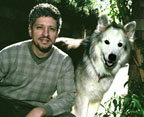|
Web
Exclusives:Features October
10, 2001:
By Rob MacKay '89 An English major, Hawthorne is founder and CEO of Genetic Savings & Clone, a commercial and research leader in the effort to clone animals. With offices in Mill Valley, California, and laboratories and a ranch in Texas, GSC has a gene bank that stores DNA from cherished pets, prized livestock, champion horses, endangered species, and crack rescue dogs. Soon they will be duplicated, claims Hawthorne. "Whether your animal is a champion bull, a rare white tiger, or a beloved mutt, GSC is the best place to store its DNA — and perhaps clone it in the near future!" reads a stanza from www.savingsandclone.com. The almost two-year-old company features a herd of well-respected scientists, medical doctors, and cryopreservation experts. Hawthorne says that they've already successfully cloned two bulls and a goat. But the main focus of the moment is to clone a benefactor's beloved dog, Missy. The idea for GSC has roots in a very rich couple with an eccentric love for their 14-year-old mixture of border collie and Siberian husky. Soon after the cloned sheep Dolly made international headlines, Missy's owners, in August of 1998, gave researchers who work out of Texas A&M $2.3 million to make a carbon copy of their pooch. (Details of Missy's story are available at www.missyplicity.com). So far, it's been a complicated endeavor, says Hawthorne. Dogs have unusual reproductive cycles, and the eggs of females mature just before the dog goes into heat, which happens infrequently and unpredictably. Thus, there is a chronic shortage of canine eggs and female dogs in heat that can be used as surrogate moms. (The Texas A&M team keeps as many as 80 female dogs on hand with the hopes of at least one being in heat at all times.) Hawthorne gives 50/50 odds that it will be done by the end of 2001. Then the sky's the limit. "Dogs are difficult. Cats are much easier," he says. "And if we wanted to clone humans, we'd be done by now. So much more is known about humans and their genetics...But don't worry, we're not interested in humans. Even if you could do it without the ethical risks, there's no money in it." GSC has spent around $3.7 million so far in research and other expenditures, and cloning Missy will probably end up costing $5 million before it's a reality, Hawthorne thinks. Once it happens, annual revenues will skyrocket. GSC has a long list of dog owner clients whose pets' DNA can be found in company petri dishes, and after the first reproduction, the process will get easier and cheaper. "It's kind of like the Manhattan Project," he says. "The hardest part is doing it once. It's all downhill from there." Hawthorne predicts that after three years, they will be able to offer the service for $10,000-$20,000. It may eventually become affordable for most pet owners in the U.S. As D-Day approaches, Hawthorne says he has no major moral issues with his vocation. GSC has an advisory board which includes leading experts in the field of bioethics. The company will never engage in any transgenic or gene-changing work without the board's approval. "I'm an ethical pragmatist," he says. "I'm not concerned with playing God, my concerns are for the well-being of living beings, and people really want this." www.savingsandclone.com Rob MacKay is an editor at a weekly newspaper in Queens called the Timesnewsweekly. He can be reached at robertazo@hotmail.com
|

 Louis
Hawthorne '83 is closing in on the day when endangered species will
no longer face extinction, accomplished thoroughbreds will have
to beat themselves to win major races, and cats will enjoy their
ninth life and continue on to an infinity of reincarnations.
Louis
Hawthorne '83 is closing in on the day when endangered species will
no longer face extinction, accomplished thoroughbreds will have
to beat themselves to win major races, and cats will enjoy their
ninth life and continue on to an infinity of reincarnations.